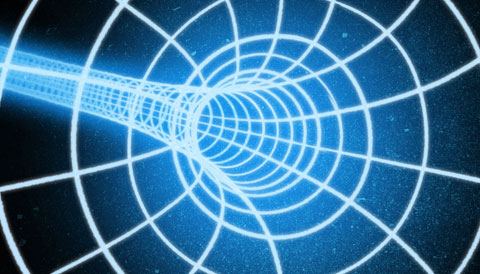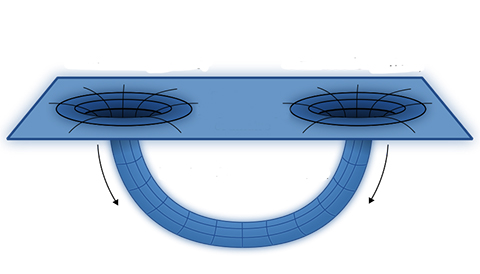Hoping for faster-than-light travel? Wormholes aren’t the paths you’re looking for.
It’s a standard sci-fi trope: Space travelers in a hurry pop into a wormhole and reach a distant part of the galaxy faster than light could traverse the space in between. The scenario is not entirely divorced from reality, since in certain circumstances wormholes are theoretically possible.
But unfortunately for spacefarers, even if wormholes do exist, they are not a solution for faster-than-light travel. In fact any trip through a wormhole would take longer than the same trip through normal space.
Some of you may have just gasped. How will Odo find his fellow Changelings? Did Major Samantha Carter lie to us for 10 seasons of stargate adventures?
Theorists are still figuring out the nuances of wormhole physics, but as Juan Maldacena (Institute for Advanced Study) explained at the Black Hole Initiative Annual Conference in Cambridge, Massachusetts, both quantum and gravitational constraints would prevent wormhole travel from breaking the cosmic speed limit. But they could potentially permit a “long” wormhole to exist, one that enabled slower travel between regions, at least as measured by someone outside the tunnel.
Think of spacetime as a rubber sheet. It can curve, warp, and so on — be distorted into a saddle shape or closed in on itself like a sphere. Not all setups are equal: Some configurations change the way points on the sheet’s surface are connected to one another. The nature of a surface’s inherent connectness is called its topology.
A wormhole is a particular topology of spacetime’s rubber sheet, in which the geometry of space is deformed such that two separate regions connect to one another. Think of it like the hollow handle on a water jug: The liquid can enter the bottom hole of the handle, traverse its curve, and come out the other handle hole higher up, without having traveled through the jug’s main body.
Geometry and gravity are intimately connected in our current understand of gravity, Einstein’s general theory of relativity. In this framework, gravity is geometry. What we experience as a force pulling our feet toward Earth is actually us falling into the dip our planet makes in spacetime. All matter makes dips — some more pronounced than others — in the cosmic rubber sheet. As the pioneering physicist John Wheeler used to say, matter tells spacetime how to curve, and curved spacetime tells matter how to move. That is gravity.
Einstein’s equations generally forbid long wormholes when matter is involved, making only one-way black holes possible. But work by Maldacena and his collaborators suggests that in very special circumstances, quantum effects provide the right kind of energy to keep the wormhole open. (Watch Maldacena’s talk for the dirty details.)
Since a wormhole is an extreme warping of spacetime, it’s a place of extreme gravity. From outside, it would look like a black hole; only when you went into it would you discover that there’s no event horizon, Maldacena said.
Now, if wormholes are gravitational things, then they’re also bound by gravity’s speed limit — namely, the speed of light in a vacuum. So superluminal travel inside the tunnel is impossible.
But couldn’t the path traversed in a wormhole be physically shorter than the path through unwarped, “flat” space, and so a faster trip is still possible?
Unfortunately, it doesn’t work out that way. The reason a wormhole trek would take longer than one through flat space is something called time dilation. Remember that gravity is the warping of spacetime, which means it’s the warping of both space and time. Deep inside a strong gravitational field, time passes more slowly than it does at the edges. We see this effect with GPS satellites. Because satellites orbit far above Earth, they’re higher up in the gravitational well that our planet creates. The result is that GPS satellite clocks tick off 38 more microseconds per day than ground-based clocks do.
Since wormholes are places of extreme gravity, time dilation would be pronounced, with time flowing far more slowly inside the wormhole than outside it. Although someone traveling through the wormhole would think time is passing normally, what matters for efficient space travel is the passage of time outside the wormhole, not inside. The whole point is to arrive somewhere faster than is possible in normal space. Sadly, to an outside observer, wormhole travel would take a really, really long time.
So even if wormholes exist, they’re not going to help Captain Sisko get to the Gamma Quadrant before dinner.
 1
1











Comments
bwana
June 17, 2018 at 4:19 pm
I'll believe it when the first wormhole traveler returns from some place millions of light-years away...
bwa
You must be logged in to post a comment.
You must be logged in to post a comment.